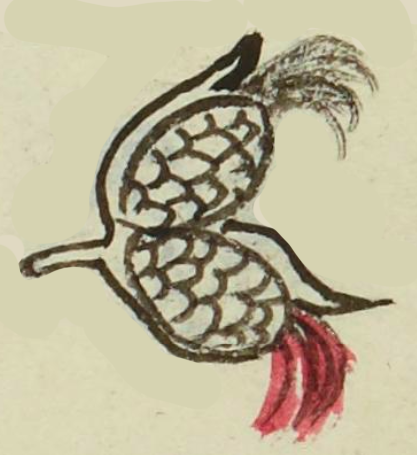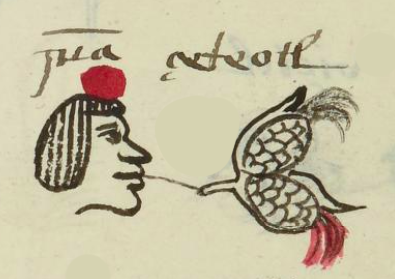Centeotl (MH834v)
This simplex glyph for the personal name Centeotl ("Divine Force of Ears of Maize," attested here as pertaining to a man) shows two cobs of corn on one short stem. The ears are nearly horizontal. Their husks are peeled back to expose the kernels, making it clear what they are. Each cob also has silk at the top. The silk of the lower ear is painted red.
Stephanie Wood
That this name of a divine force associated with maize is still in use in 1560 is notable as an example of pre-contact religious survival. Other translations for Centeotl can be found, seemingly relating to the translation of "cen" as entire, or as one, or only.
The letter e and the letter i can be interchangeable in certain words such as cintli and centli, referring to an ear of maize.
Stephanie Wood
juā çeteotl
Juan Centeotl
Stephanie Wood
1560
Jeff Haskett-Wood
divine forces, fuerzas divinas, deidades, deities, divinities, divinidades, maize, maíz, cintli, centli, nombres de hombres

Cinteo(tl), a name, associated with the Ear-of-Maize divine force or deity, https://nahuatl.wired-humanities.org/content/cinteotl
cin(tli), dried ear of maize, https://nahuatl.wired-humanities.org/content/cintli
teo(tl), divine force(s), https://nahuatl.wired-humanities.org/content/teotl
cen, entirely, https://nahuatl.wired-humanities.org/content/cen
cen-, one, https://nahuatl.wired-humanities.org/content/cen-0
Matrícula de Huexotzinco, folio 834v, World Digital Library, https://www.loc.gov/resource/gdcwdl.wdl_15282/?sp=743&st=image
This manuscript is hosted by the Library of Congress and the World Digital Library; used here with the Creative Commons, “Attribution-NonCommercial-ShareAlike 3.0 License” (CC-BY-NC-SAq 3.0).





